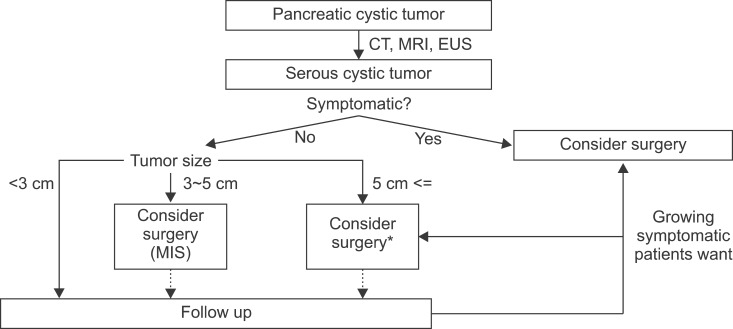Korean J Hepatobiliary Pancreat Surg.
2011 May;15(2):134-138. 10.14701/kjhbps.2011.15.2.134.
Serous Cystic Neoplasm: Do We Have to Wait Till It Causes Trouble?
- Affiliations
-
- 1Department of Surgery, Yonsei University College of Medicine, Korea. cmkang@yuhs.ac
- 2Department of Radiology, Yonsei University College of Medicine, Korea.
- 3Department of Pathology, Yonsei University College of Medicine, Korea.
- 4Department of Internal Medicine, Yonsei University College of Medicine, Korea.
- 5Department of Medical Oncology, Yonsei University College of Medicine, Korea.
- 6Pancreaticobiliary Cancer Clinic, Yonsei University Health System, Korea.
- 7Young Yonsei Pancreatic Tumor Study Group, Korea.
- KMID: 1980953
- DOI: http://doi.org/10.14701/kjhbps.2011.15.2.134
Abstract
- Serous cystic neoplasm (SCN) of the pancreas is considered a benign tumor with almost no malignant potential. Most surgeons agree that asymptomatic SCN requires only regular observation. However, several complexities and interference with organ preservation during the operation, may develop when a huge symptomatic tumor is treated with surgery. So, the purpose of this study is to develop a potential management plan based on a literature review and by describing three recent cases of SCN of the pancreas. We suggest that SCNs be responded to with a timely and appropriate surgical intervention - before they require clinical attention.
Keyword
Figure
Cited by 2 articles
-
Clinicoradiological features of resected serous cystic neoplasms according to morphological subtype and preoperative tentative diagnosis: can radiological characteristics distinguish serous cystic neoplasms from other lesions?
Jae Seung Kang, Hyo Jun Kim, Yoo Jin Choi, Yoonhyeong Byun, Jeong Min Lee, Youngmin Han, Hongbeom Kim, Wooil Kwon, Jin-Young Jang
Ann Surg Treat Res. 2020;98(5):247-253. doi: 10.4174/astr.2020.98.5.247.Serous cystic neoplasm: Do we have to wait till it causes trouble? Season 2
Min Chul Shin, Hye Yeon Yang, Ji Su Kim, Chang Moo Kang
Ann Hepatobiliary Pancreat Surg. 2023;27(2):217-219. doi: 10.14701/ahbps.22-050.
Reference
-
1. Becker WF, Welsh RA, Pratt HS. Cystadenoma and cysta denocarcinoma of the pancreas. Ann Surg. 1965; 161:845–863. PMID: 14295937.2. ReMine SG, Frey D, Rossi RL, Munson JL, Braasch JW. Cystic neoplasms of the pancreas. Arch Surg. 1987; 122:443–446. PMID: 3566528.
Article3. George DH, Murphy F, Michalski R, Ulmer BG. Serous cystadenocarcinoma of the pancreas: a new entity? Am J Surg Pathol. 1989; 13:61–66. PMID: 2909198.4. King JC, Ng TT, White SC, Cortina G, Reber HA, Hines OJ. Pancreatic serous cystadenocarcinoma: a case report and review of the literature. J Gastrointest Surg. 2009; 13:1864–1868. PMID: 19459016.
Article5. Fernández-del Castillo C, Targarona J, Thayer SP, Rattner DW, Brugge WR, Warshaw AL. Incidental pancreatic cysts: clinicopathologic characteristics and comparison with symptomatic patients. Arch Surg. 2003; 138:427–433. PMID: 12686529.6. Sahani D, Prasad S, Saini S, Mueller P. Cystic pancreatic neoplasms evaluation by CT and magnetic resonance cholangiopancreatography. Gastrointest Endosc Clin N Am. 2002; 12:657–672. PMID: 12607778.7. Yoon WJ, Lee JK, Lee KH, Ryu JK, Kim YT, Yoon YB. Cystic neoplasms of the exocrine pancreas: an update of a nationwide survey in Korea. Pancreas. 2008; 37:254–258. PMID: 18815545.8. Birkmeyer JD, Warshaw AL, Finlayson SR, Grove MR, Tosteson AN. Relationship between hospital volume and late survival after pancreaticoduodenectomy. Surgery. 1999; 126:178–183. PMID: 10455881.
Article9. Strobel O, Z'graggen K, Schmitz-Winnenthal FH, et al. Risk of malignancy in serous cystic neoplasms of the pancreas. Digestion. 2003; 68:24–33. PMID: 12949436.
Article10. Tseng JF, Warshaw AL, Sahani DV, Lauwers GY, Rattner DW, Fernandez-del Castillo C. Serous cystadenoma of the pancreas: tumor growth rates and recommendations for treatment. Ann Surg. 2005; 242:413–419. PMID: 16135927.11. Balcom JH 4th, Rattner DW, Warshaw AL, Chang Y, Fernandez-del Castillo C. Ten-year experience with 733 pancreatic resections: changing indications, older patients, and decreasing length of hospitalization. Arch Surg. 2001; 136:391–398. PMID: 11296108.
- Full Text Links
- Actions
-
Cited
- CITED
-
- Close
- Share
- Similar articles
-
- Serous cystic neoplasm: Do we have to wait till it causes trouble? Season 2
- Differential diagnosis of cystic diseases of pancreas
- A Serous Cystic Neoplasm of the Pancreas with Synchronous Pancreatic Ductal Adenocarcinoma
- Malignant Pancreatic Serous Cystic Neoplasm: A Case of Local Recurrence and Liver Metastasis that Occurred During Follow-Up
- Cystic Neoplasm of the Pancreas: Its Diagnosis and Treatment





